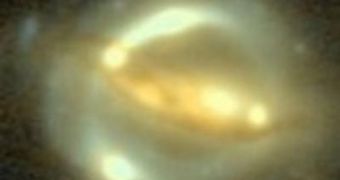One of the most important goals in astronomy has always been discovering the exact age of the Universe, its dimensions, as well as its origins. People have been fascinated with these questions since the days when Og first looked at the skies. Measurements of these traits can now be conducted with scientific rigor via a number of methods, but researchers are currently adding another one to the list. Gravitational lensing, the art of using entire galaxies as magnifying lenses to see what's behind them, is slowly becoming a very precise observations method, on par with all other existing ones. In addition, the new method also provides experts with a way of verifying other results.
Thus, research teams around the world were able to conclude that the Hubble constant is indeed in the boundaries set for it by other research methods, and that the Universe is therefore around 13.75 billion years old. The margin for error in the new estimates is between plus/minus 170 million years. Another great advantage that gravitational lensing brings to the table is the knowledge that dark energy indeed exists, and that the stuff is strong enough to constantly accelerate the Universe, as theorists have proposed. Details of the new investigations appear in the March issue of The Astrophysical Journal.
The work was conducted by experts at the US Department of Energy's (DOE) SLAC National Accelerator Laboratory, and the Stanford University, who together operate the Kavli Institute for Particle Astrophysics and Cosmology (KIPAC). This team worked with German colleagues from the University of Bonn, as well as with scientists from other American and German research institutions, on improving the use of gravitational lensing, and therefore making the end results more accurate. The investigation revolved around combining data from the NASA/ESA Hubble Space Telescope with information collected by the Wilkinson Microwave Anisotropy Probe (WMAP).
"We've known for a long time that lensing is capable of making a physical measurement of Hubble's constant. Gravitational lensing has come of age as a competitive tool in the astrophysicist's toolkit,” explains Phil Marshall, who is a team member based at KIPAC. He explains that the method has been around for a while, but that it was never before used in such a precise way, to produce such accurate results. Partial funding for this groundbreaking work came in from the DOE Office of Science.

 14 DAY TRIAL //
14 DAY TRIAL //